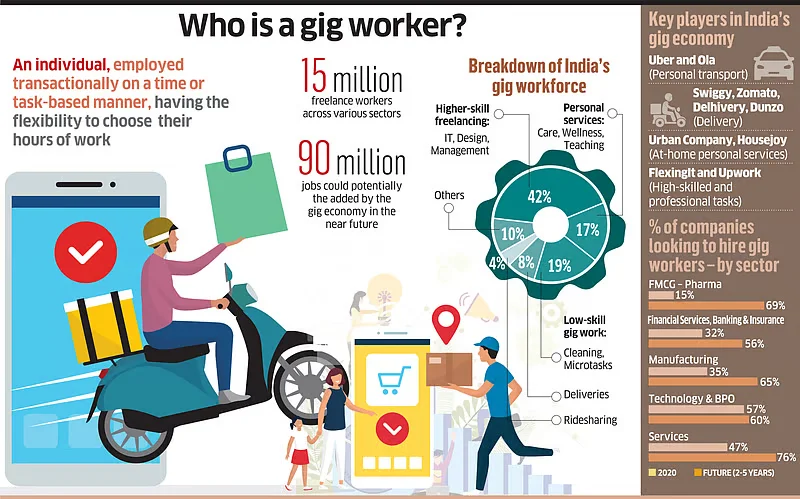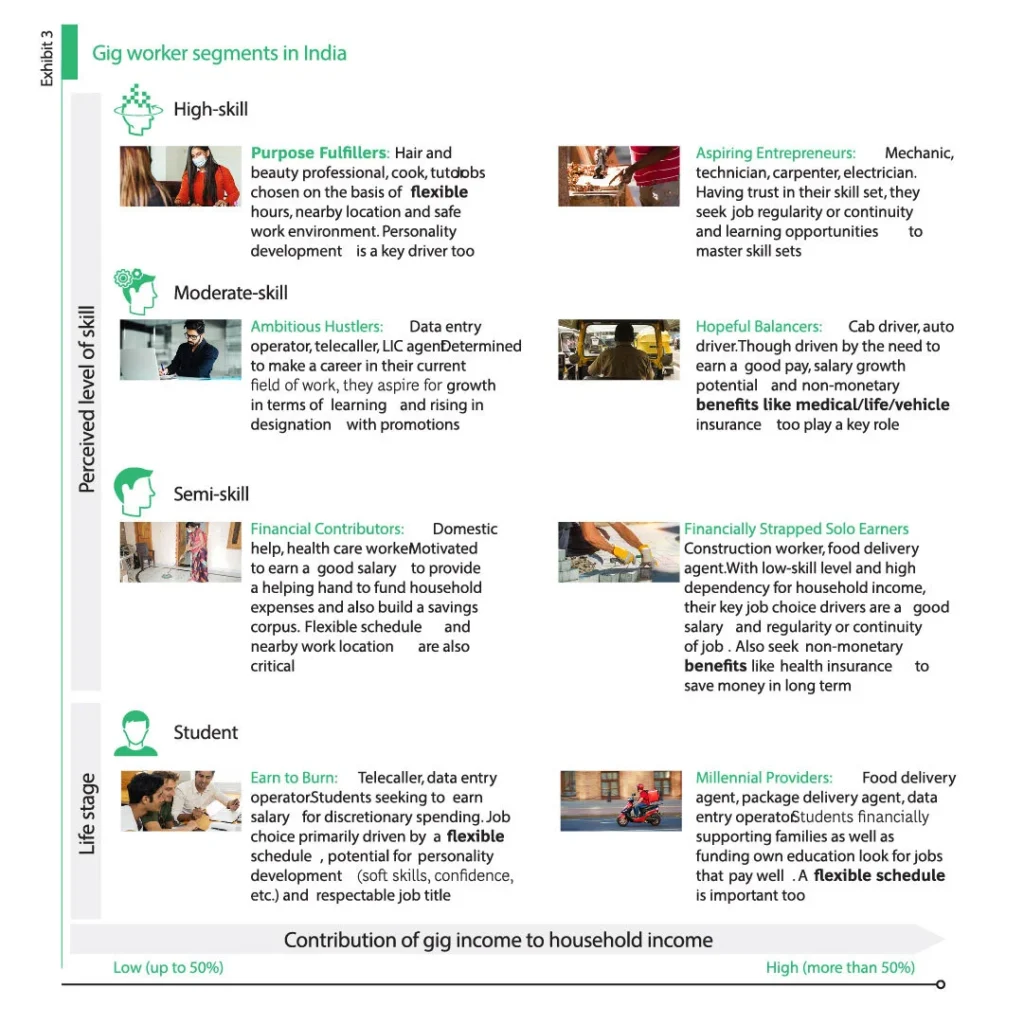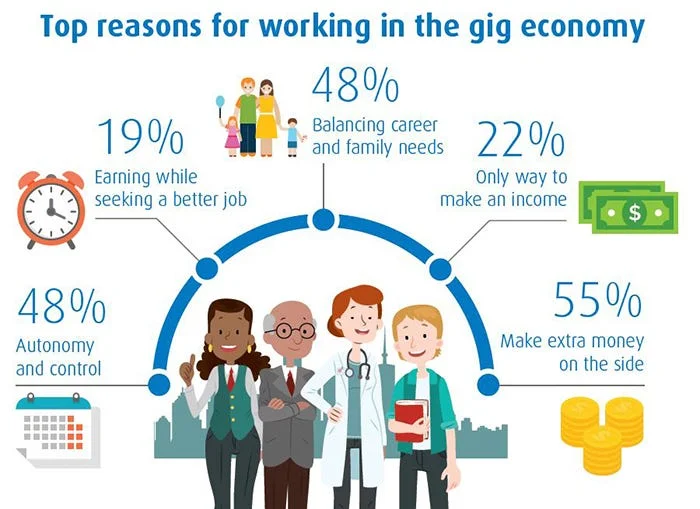Why in NEWS
The Union Budget 2025–26 has officially acknowledged gig and platform workers, extending social protection to them. However, the Periodic Labour Force Survey (PLFS) still lacks a separate classification for these workers, creating a data-policy mismatch that hinders effective labour reforms and welfare targeting.
Key Concepts and Definitions
| Term | Description |
|---|---|
| Gig Economy | Labour system of short-term, task-based, and flexible work, often digital. |
| Gig Worker (Code, 2020) | One who earns from task-based work outside traditional employment. |
| Platform Worker | Gig worker operating through digital platforms like Zomato or Uber. |
| e-Shram | National portal to register and provide benefits to unorganized workers. |
| PLFS | Survey by MoSPI to gather labour market data in India. |
What is the Gig Economy and What are the Current Gaps in Its Classification?
| Feature | Explanation |
|---|---|
| Definition | Task-based, non-traditional work often through digital apps or platforms. |
| Data Gap | PLFS lumps gig workers under casual/self-employed categories. |
| Impact of Gap | Exclusion from welfare schemes, legal ambiguity, inaccurate policy design. |

What is Driving the Gig Economy in India?
| Factor | Details |
|---|---|
| Digital Penetration | 936 million internet, 650 million smartphone users enabling platform access. |
| Startup & E-Commerce Boom | Growing demand for flexible workers in logistics, content, and delivery. |
| Youth Preference | Flexibility and work-life balance attract young professionals. |
| Urban Consumer Demand | Need for on-demand services fuels growth in gig roles. |
| Labour Surplus | High unemployment and underemployment push workforce into gig jobs. |

What is the Economic Significance of the Gig Economy?
| Contribution Area | Highlights |
|---|---|
| Informal to Formal Shift | Gig platforms absorb informal labour into structured income-generating work. |
| Inclusive Growth | Women and rural workers gain income via flexible home-based tasks. |
| Entrepreneurial Push | Self-employment on platforms like Uber promotes innovation. |
| Tech-Driven Growth | Enhances digital transactions, service access, and data formalization. |
| Fiscal Contribution | Tax revenue through digital payments and regulated gig earnings. |

What are the Challenges Faced by Gig Workers in India?
| Challenge Area | Description |
|---|---|
| No Comprehensive Security | Fragmented schemes like e-Shram and PM-JAY; no income guarantee or paid leave. |
| Income Volatility | Monthly earnings (₹15k–₹20k) often below minimum wage; 70% face high platform deductions. |
| Long Working Hours | 78% work over 10 hours/day; health and mental stress due to algorithmic control. |
| Arbitrary Deactivation | 80%+ face sudden app bans; 70% report customer abuse with no effective grievance redressal. |
| Lack of Legal Clarity | Social Security Code recognizes gig workers but omits core rights like minimum wage. |
India’s Key Initiatives for Gig Workers
| Initiative | Purpose |
|---|---|
| Code on Social Security, 2020 | Legal definition of gig/platform workers |
| e-Shram Portal | Central database of unorganized workers, including gig workers |
| PM Shram Yogi Maandhan | Voluntary pension scheme for informal workers |
| Rajasthan Gig Workers Welfare Act (2023) | Registration, grievance redressal, and welfare board for gig workers |
What Measures Are Needed to Strengthen the Gig Economy Framework?
| Domain | Recommendations |
|---|---|
| Data & Classification | Update PLFS to identify gig workers distinctly; integrate e-Shram for real-time tracking. |
| Social Protection | Expand to include pensions, paid leave, maternity cover, and minimum wage norms. |
| Legal Framework | Guarantee labour rights: work hour limits, dispute resolution, and collective bargaining. |
| Platform Accountability | Transparent grievance systems; penalise unjust deactivations or harassment. |
| Incentives & Local Policies | States to offer subsidies and preferences to fair platforms; replicate Rajasthan’s model. |
In a Nutshell
Memory Code: “GIG-SAFE”
G – Government recognition
I – Inclusive growth
G – Grievance redressal
S – Social security expansion
A – Accurate classification
F – Fair pay
E – e-Shram integration
Prelims Questions
- According to the Code on Social Security, 2020, a gig worker is:
A. A government-employed worker
B. A contract employee under a company
C. A person outside traditional employment earning per task
D. A migrant worker from rural India - Which of the following is true regarding the gig economy in India?
A. Gig workers are covered under the EPF and ESI
B. PLFS has a distinct category for gig workers
C. Most gig workers are salaried professionals
D. Many face algorithmic control without formal protections - What is the function of the e-Shram Portal?
A. It provides agricultural subsidies
B. It certifies organic food producers
C. It registers unorganized workers including gig workers
D. It handles GST compliance for startups
Mains Questions
- What are the legal and policy-level reforms required to ensure fair and secure livelihoods for gig and platform workers in India? (GS II – Governance)
- Discuss the role of digital platforms in reshaping India’s labour market. How can India balance growth and welfare in the gig economy? (GS III – Economy)
Prelims Answer Key
| Question No. | Correct Answer | Explanation |
|---|---|---|
| 1 | C | As per Code on Social Security, gig workers earn outside formal employment |
| 2 | D | Many gig workers operate under algorithmic systems with limited legal protection |
| 3 | C | e-Shram Portal registers unorganized sector and gig/platform workers |
















